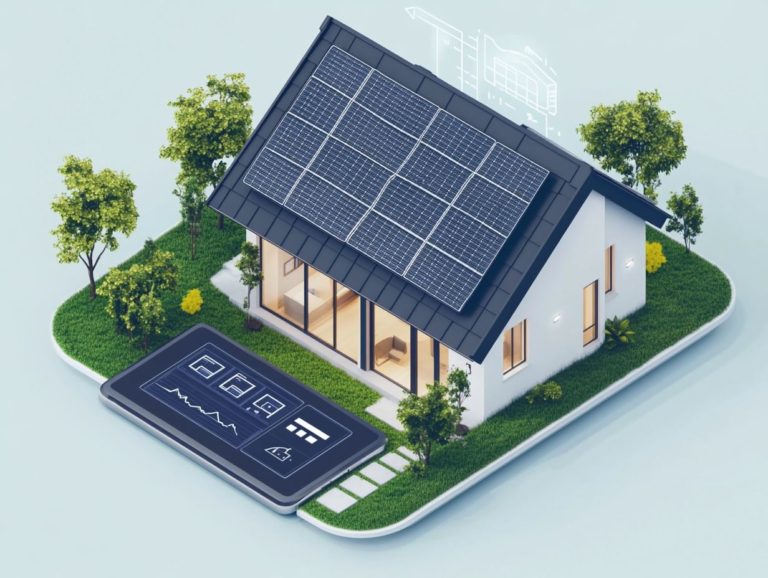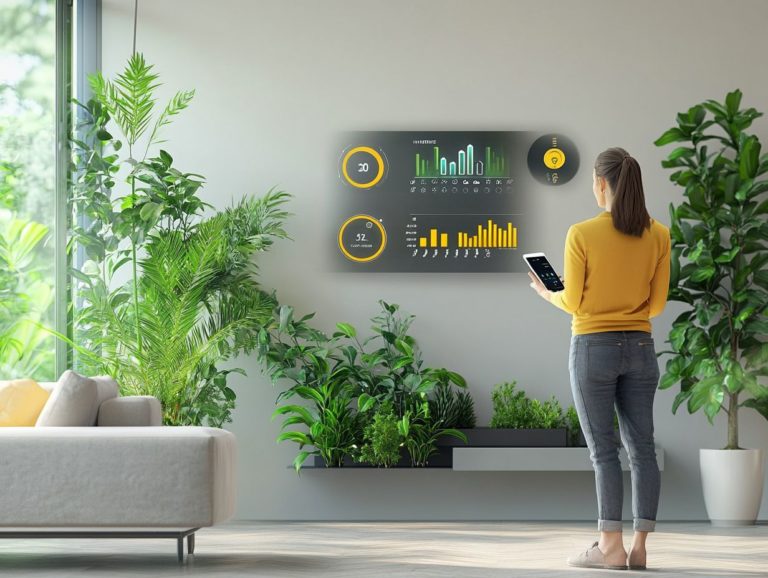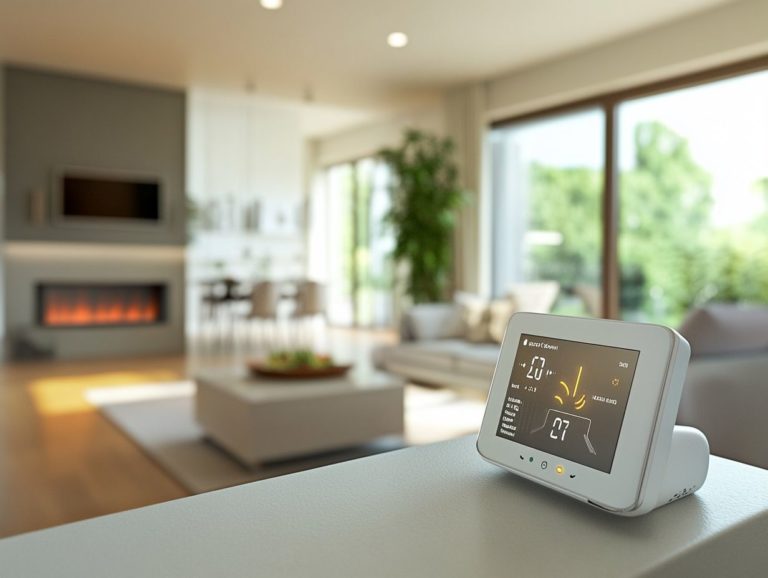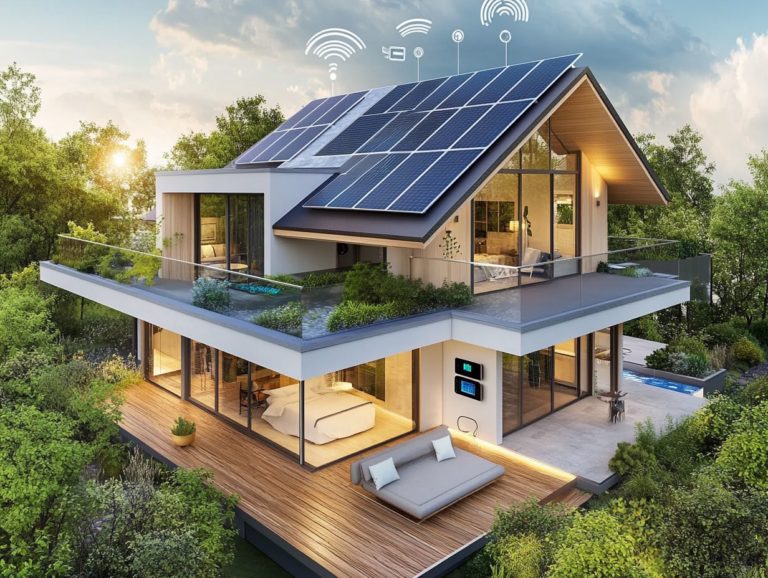5 Ways to Utilize Smart Home Tech for Savings
In today s world, smart home technology transcends mere trends; it stands as a formidable ally in your quest for saving money and boosting energy efficiency. These innovations will slash your utility costs, making them a must-have!
Consider the benefits of smart thermostats that seamlessly adjust heating and cooling based on your daily habits. Smart lighting systems can significantly reduce your electricity bills. These innovations are worthy investments that can profoundly impact your utility costs.
This article delves into five key strategies for harnessing smart home devices to achieve financial savings. It also thoughtfully addresses initial investment considerations, how to effectively track your savings, and potential risks involved.
Discover how you can transform your living space into a more efficient and cost-effective haven.
Contents
- Key Takeaways:
- 1. Smart Thermostats for Energy Efficiency
- 2. Smart Lighting for Lower Electricity Bills
- 3. Smart Plugs for Monitoring and Reducing Energy Usage
- 4. Smart Appliances for Lower Utility Costs
- 5. Smart Home Security for Potential Insurance Savings
- How Can Smart Home Technology Help Save Money?
- What Are the Different Types of Smart Home Technology?
- What Are the Initial Costs of Implementing Smart Home Technology?
- How Can a Homeowner Track Their Savings from Smart Home Technology?
- What Are the Potential Risks of Using Smart Home Technology?
- What Are Some Other Ways to Save Money with Smart Home Technology?
- Frequently Asked Questions
- What are the benefits of using smart home tech for savings?
- What are some easy ways to incorporate smart home tech for savings?
- Can smart home technology really save me money on my utility bills?
- Are there any upfront costs associated with using smart home technology for savings?
- What type of smart home technology is best for saving money on energy costs?
- Can smart home technology help me save money in other ways besides energy costs?
Key Takeaways:
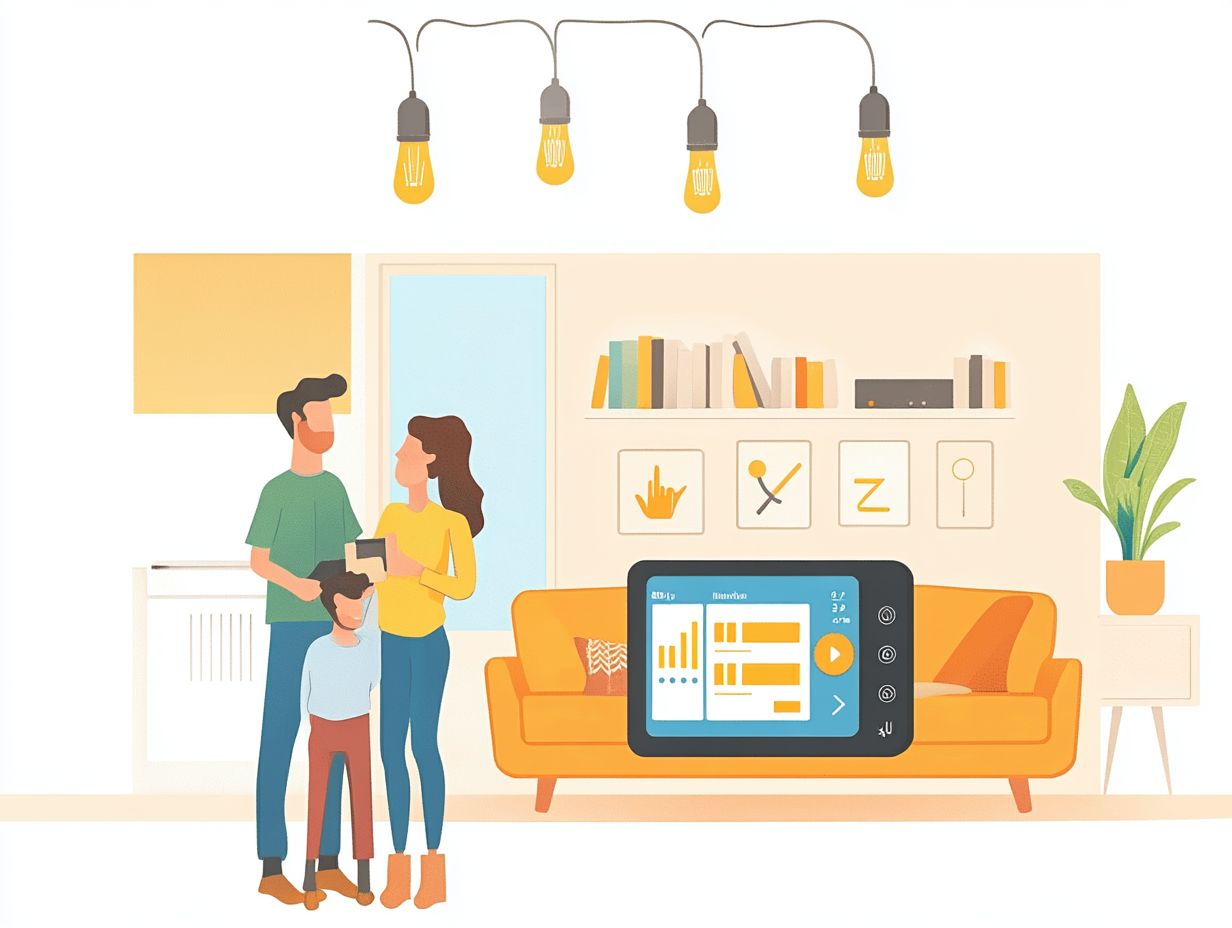
- Maximize energy efficiency and lower utility costs with smart thermostats that can be programmed and controlled remotely.
- Reduce electricity bills with smart lighting that can be timed and adjusted for optimal usage.
- Monitor and control energy usage with smart plugs, potentially saving on unnecessary energy expenses.
1. Smart Thermostats for Energy Efficiency
Smart thermostats are transforming the way you manage your heating and cooling systems, bringing energy efficiency to the forefront. By intelligently adjusting temperature settings based on your occupancy and usage patterns, these innovative devices can significantly reduce energy consumption.
This leads to lower energy bills and a smaller carbon footprint. With choices like Nest, Ecobee, and Energy Star certified models at your fingertips, you can harness advanced automation features to optimize your heating, ventilation, and air conditioning (HVAC) systems and enhance operational efficiency all while contributing to a more sustainable future.
Occupancy sensors in these devices adjust the temperature based on whether anyone is home, ensuring you don t waste energy on empty spaces. Plus, with remote access through mobile apps, you can monitor and control your thermostat from anywhere, adding an extra layer of convenience to your energy management routine.
Certifications like Energy Star not only validate the energy efficiency of these models but also align with broader environmental objectives aimed at reducing carbon emissions. By embracing smart thermostats, you can take significant strides toward achieving your energy conservation goals and supporting the transition to carbon-free energy solutions.
2. Smart Lighting for Lower Electricity Bills
Smart lighting systems are essential for not only slashing electricity bills but also elevating the ambiance of your modern home. By merging energy-efficient standards with cutting-edge technology, these systems give you control of your lighting like never before.
With smart bulbs and switches at your disposal, you can effortlessly manage your lights through mobile apps or voice commands, optimizing energy usage and reducing waste.
These innovative solutions present a wealth of options, allowing you to choose from various color temperatures and brightness levels tailored to your preferences or activities be it a cozy reading nook or a lively gathering with friends. When integrated with home automation systems, the convenience factor skyrockets.
You can synchronize your lighting with smart thermostats or security devices, creating a seamless smart home experience. Imagine having customized schedules set up so your lights automatically turn on or off at specific times, ensuring energy is only consumed when needed.
And with compatibility across voice-activated assistants, adjusting your lighting is a breeze no need to lift a finger.
Start your journey towards a smarter, more cost-effective home today!
3. Smart Plugs for Monitoring and Reducing Energy Usage
Smart plugs are an essential component of your smart home ecosystem. They give you the power to effortlessly monitor and control your energy consumption while optimizing usage for big savings. These smart devices let you see how much energy you use, offering valuable insights that can inspire more efficient energy management.
With their compatibility across a wide range of smart home systems, you can control smart plugs remotely via mobile apps. This makes it incredibly easy to minimize energy waste and reduce utility costs.
Beyond real-time monitoring, smart plugs enable you to set schedules, which can greatly enhance your energy savings, especially during peak hours when energy costs tend to soar. By integrating seamlessly with other smart devices like thermostats and lighting systems, these plugs elevate your smart home experience to new heights. For instance, you can program your devices to automatically turn off or dim during times you re away, further optimizing your energy consumption while benefiting the environment.
This seamless interaction not only streamlines your daily routines but also equips you with the tools you need to make informed decisions about your energy use. Start monitoring your energy use now, so you can save money today!
4. Smart Appliances for Lower Utility Costs
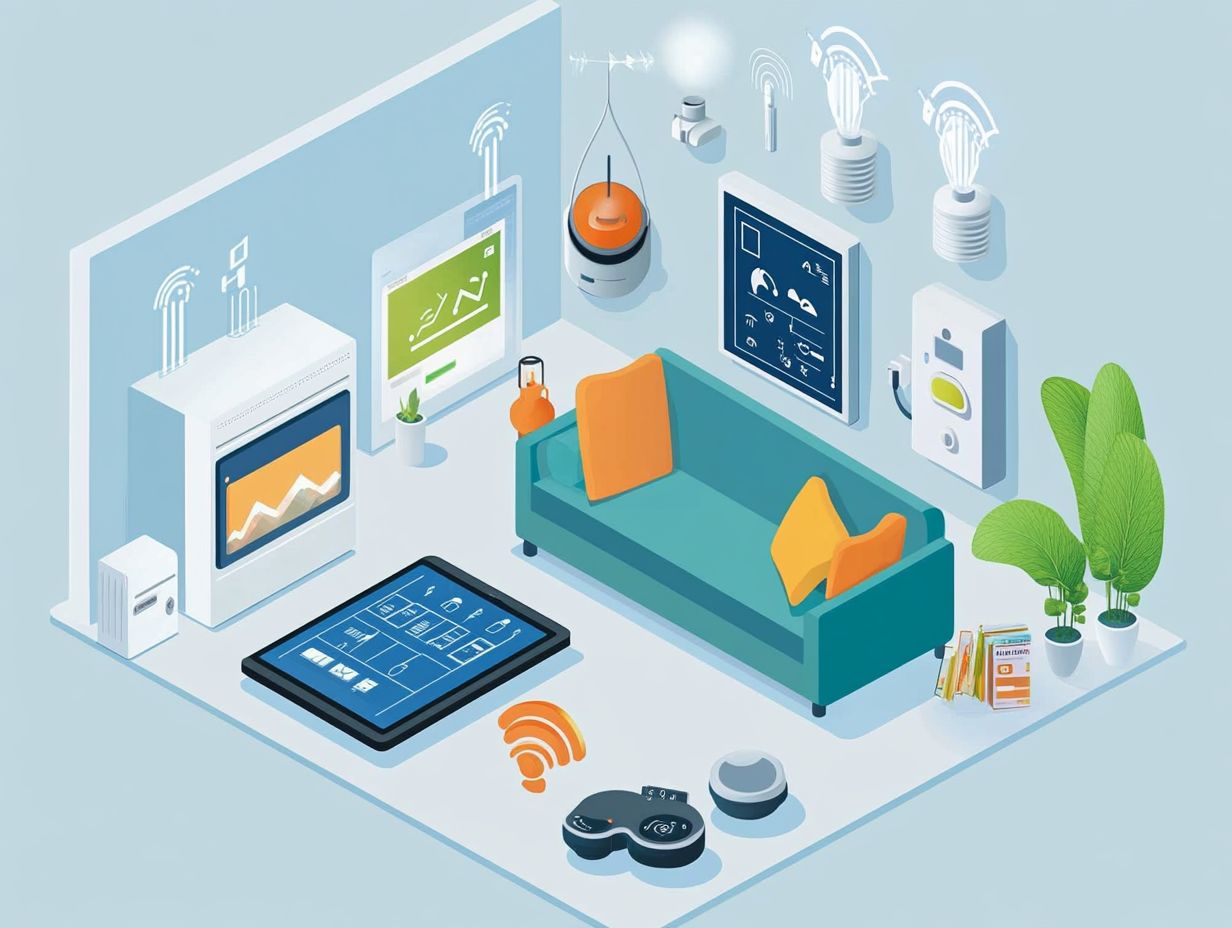
Smart appliances change the way you handle everyday tasks. Enjoy incredible convenience while cutting down on utility costs and achieving energy savings. By adhering to energy-efficient standards, these devices boost efficiency and help reduce your household’s overall carbon footprint.
From smart refrigerators to advanced washing machines, you can harness the power of smart home systems to monitor usage, paving the way for smarter energy consumption and reduced electric bills. Consider implementing 5 essential energy efficiency upgrades for homes to further enhance your energy savings.
Among the array of smart appliances at your disposal, smart thermostats like the Nest Learning Thermostat allow you to track temperature schedules and adjust settings remotely, leading to significant energy savings. Advanced laundry machines from brands like LG and Samsung provide features such as steam cleaning and optimal load sensing, intelligently adjusting water and electricity usage based on the size of your laundry load.
These appliances easily work together with energy monitoring systems, giving you the ability to visualize your energy consumption patterns over time so you can make informed decisions to maximize your savings. Brands like Ecobee and Whirlpool are at the forefront of smart home integration, giving you the power to optimize energy use while reveling in the benefits of modern technology.
5. Smart Home Security for Potential Insurance Savings
Smart home security systems offer you not just enhanced protection for your residence but also the potential for substantial insurance savings, making them a savvy investment for any homeowner.
By integrating smart devices like leak sensors and water leak detectors, these systems deliver real-time monitoring and alerts, helping you prevent damage and minimize claims. With a sophisticated home security setup, you can enjoy lower premiums and improved peace of mind, all while contributing to a reduced carbon footprint through efficient resource management.
These systems usually combine indoor and outdoor cameras, motion detectors, and smart locks that work in harmony to create a comprehensive security network. The beauty of this integration is that it allows you to manage your security measures from anywhere, providing you with ultimate convenience.
When paired with smart lighting and automation features, your entire home can dynamically respond to potential security threats, adding another layer of safety.
Insights from energy management tools help you identify patterns in your energy use, further contributing to savings on your utility bills. This advanced technology not only safeguards your assets but also fosters a more sustainable living environment.
Invest in smart security today and start saving on your insurance premiums!
How Can Smart Home Technology Help Save Money?
Smart home technology is transforming personal finance management by offering innovative solutions that save energy and lead to significant savings. By integrating a variety of smart devices and home automation systems, you can monitor your energy usage in real-time and make informed decisions that improve efficiency.
Smart thermostats and energy-efficient appliances can significantly cut your utility costs while promoting a more sustainable lifestyle through energy-efficient home renovation.
For instance, smart thermostats learn your schedule and adjust temperatures accordingly. This minimizes heating and cooling costs without compromising on comfort. Smart lighting systems equipped with LED bulbs and motion sensors ensure lights are only on when needed. Additionally, implementing 5 ways to improve your home’s efficiency can make a significant difference. Energy monitors provide valuable insights into high consumption patterns, helping you adopt smarter habits.
With home automation, you can synchronize devices to operate efficiently, further reducing energy expenses. Implementing 5 ways to reduce energy waste at home yields financial benefits and simplifies your daily routines, allowing you to focus on what truly matters.
What Are the Different Types of Smart Home Technology?
The world of smart home technology offers a remarkable array of devices designed to enhance your convenience, security, and energy management. Imagine smart appliances that make household chores easy, or smart lighting that optimizes energy usage each category plays a vital role in creating an efficient smart home.
In the realm of smart appliances, consider smart refrigerators that track food inventory and suggest recipes based on what you have. Remote-controlled smart ovens allow you to cook with precision, no matter where you are. Smart solutions like color-changing bulbs and motion sensors not only save energy but also create the perfect ambiance for any occasion.
Smart irrigation systems help you manage water usage efficiently.
Smart thermostats learn your preferences and adjust the temperature automatically for optimal comfort and energy savings. Security systems equipped with cameras, motion detectors, and smart locks help you keep an eye on your property from anywhere, enhancing peace of mind. Smart leak sensors alert you to potential water leaks, preventing costly damage.
When combined, these technologies create a seamless smart ecosystem that simplifies your daily routines while providing a living environment that s sustainable, secure, and enjoyable.
Discover how these smart devices can transform your home today!
What Are the Initial Costs of Implementing Smart Home Technology?
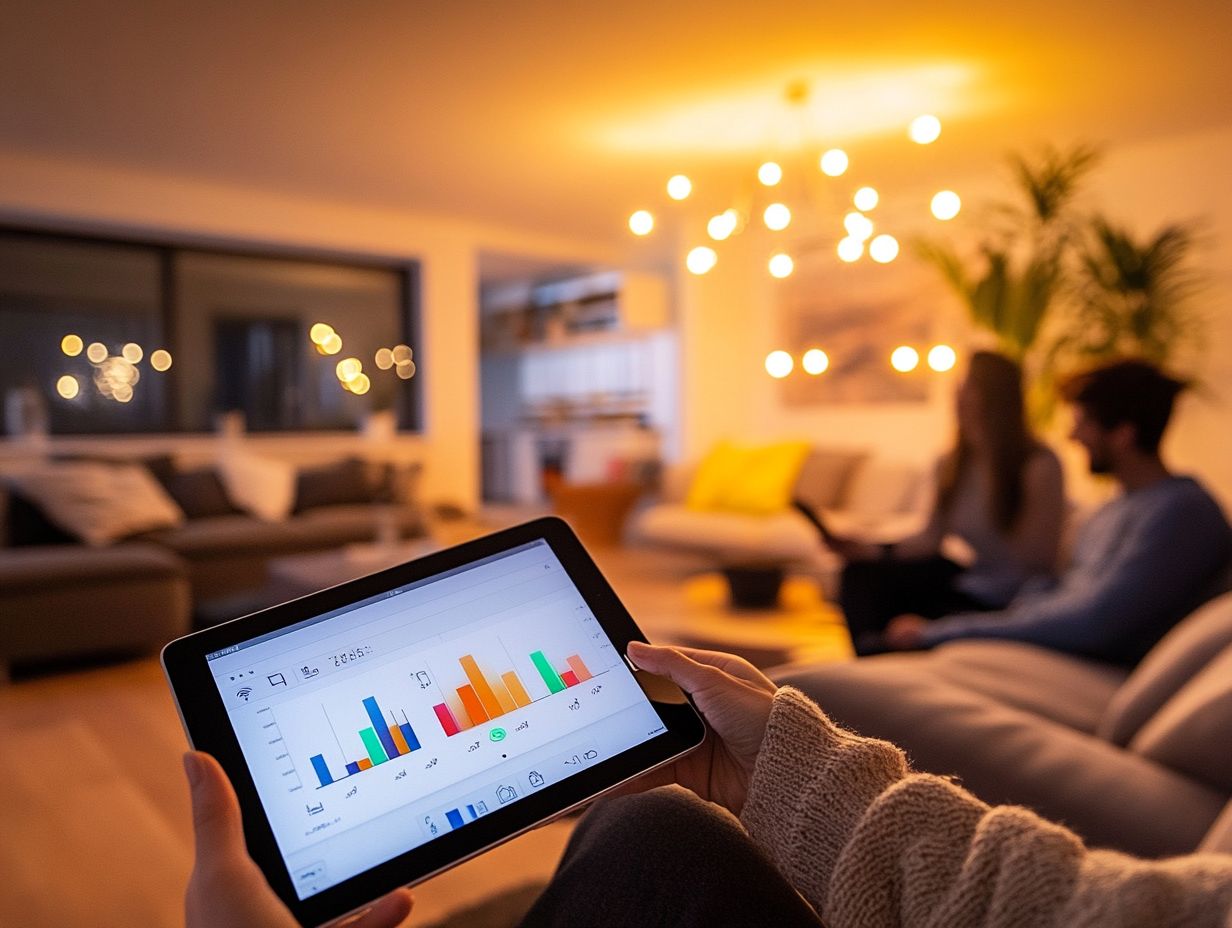
Implementing smart home technology comes with initial costs that can vary significantly, depending on the smart devices you choose and their functionalities. Plan your investments smartly for the best results! From budget-friendly smart appliances and lighting systems to high-end security features, each option should meet energy-efficient standards, which help devices use less energy, to maximize your long-term savings.
Understanding these costs is crucial for enhancing your home’s efficiency and security. Before making any purchases, it s wise to analyze not just the upfront prices but also any potential installation fees that could elevate your overall spending. Many smart devices require professional installation, and these costs can vary greatly based on the complexity of the system whether you’re integrating smart locks, thermostats, or comprehensive home security measures.
Don t overlook the ongoing service subscriptions for functionalities like cloud storage, which allows you to save data online instead of on your device, advanced monitoring, or premium app features. Evaluating these long-term costs NOW! They can make a huge difference in your savings, making a meticulous examination essential for anyone looking to make the most of their spending over the life of their smart home system. Consider also the compatibility of your devices with existing network infrastructure.
How Can a Homeowner Track Their Savings from Smart Home Technology?
You can effectively track your savings from smart home technology by utilizing energy monitoring tools and mobile apps that provide insightful data on your energy usage and costs. By analyzing patterns and trends in consumption, you can easily compare your expenses before and after implementing smart devices, allowing you to determine the financial impact of your investments in energy management.
This proactive approach not only maximizes your energy savings but also enhances your overall awareness of energy efficiency strategies for small homes within your home.
To fully optimize these benefits, consider leveraging the built-in features of your smart devices, like programmable thermostats and smart plugs, which often come equipped with performance metrics. For deeper insights, exploring smart thermostats: saving energy the smart way can be beneficial. Third-party energy monitoring systems can also provide a comprehensive overview of electricity usage across various household appliances. These systems can assist in identifying opportunities for reducing energy usage.
By utilizing dedicated mobile applications, you can streamline this process further, setting clear benchmarks and specific goals for your energy consumption. This fosters a competitive spirit, motivating you to meet and even exceed those targets. Compatibility plans from manufacturers can also ensure that all your devices work seamlessly together.
Such strategies empower you not only to save money but also to make informed decisions that contribute to a more sustainable lifestyle. For instance, using carbon-free energy sources can further reduce your carbon footprint.
Start your smart home journey today and watch your savings grow!
What Are the Potential Risks of Using Smart Home Technology?
While smart home technology certainly comes with a plethora of advantages, it s essential to be mindful of the potential risks that accompany it, such as security vulnerabilities and privacy concerns linked to smart devices. The interconnected nature of these systems can leave them open to hacking and unauthorized access if you don t take adequate security measures.
Ensuring that your home’s network infrastructure is secure is crucial. Staying informed about software improvements for your devices and best practices for safeguarding your home is vital for responsible ownership of smart home technology.
This interconnectedness brings unmatched convenience and automation but also opens the door to various cyber threats. Recognizing this is crucial! Your devices everything from smart speakers to security cameras can serve as entry points for malicious actors if they aren t secured properly. Regular software improvements are essential to maintaining security.
Data privacy is another significant concern, as many devices gather user information that could be susceptible to breaches. By implementing strong, unique passwords and enabling two-factor authentication, you can greatly enhance your security.
Regularly checking your device settings and ensuring that automatic software updates are activated will help fortify your network. This way, you can fully enjoy the benefits of your smart systems without compromising your privacy or security. Energy certifications can also offer additional guarantees of efficiency. Engaging with experts like Mitchell Klein can provide further insights into best practices for smart home technology implementation.
What Are Some Other Ways to Save Money with Smart Home Technology?
In addition to slashing energy costs, smart home technology presents a wealth of cost-saving strategies that can significantly boost your household’s financial well-being. By leveraging monitoring systems that alert you to energy-wasting habits, you can uncover countless opportunities to save money through innovative technology. Implementing automated home systems that optimize resource usage enhances convenience and unlocks substantial financial rewards.
Monitoring tools can help you track heating costs and cooling costs more accurately, ensuring efficiency. Consider installing smart thermostats that learn your preferences and adjust heating and cooling accordingly. For additional tips, check out these 5 eco-friendly energy efficiency hacks to ensure you enjoy optimal energy use without sacrificing your comfort.
You can also take advantage of smart plugs and light bulbs, which are programmable to turn off automatically when not in use, leading to a notable reduction in your electricity bills. Occupancy sensors that detect when rooms are empty can also play a pivotal role in reducing unnecessary energy usage. For renters, implementing energy efficiency solutions can make a significant impact.
By tracking energy consumption data from smart meters, you’ll empower yourself to identify peak usage times and adjust your habits accordingly. When you consolidate these features into your routine, you can create a truly efficient home that aligns with your lifestyle, all while keeping your expenses firmly in check. Utilizing smart energy-saving devices can further enhance your home’s operational efficiency. For more insights, check out these top energy-saving tips for homeowners.
Frequently Asked Questions
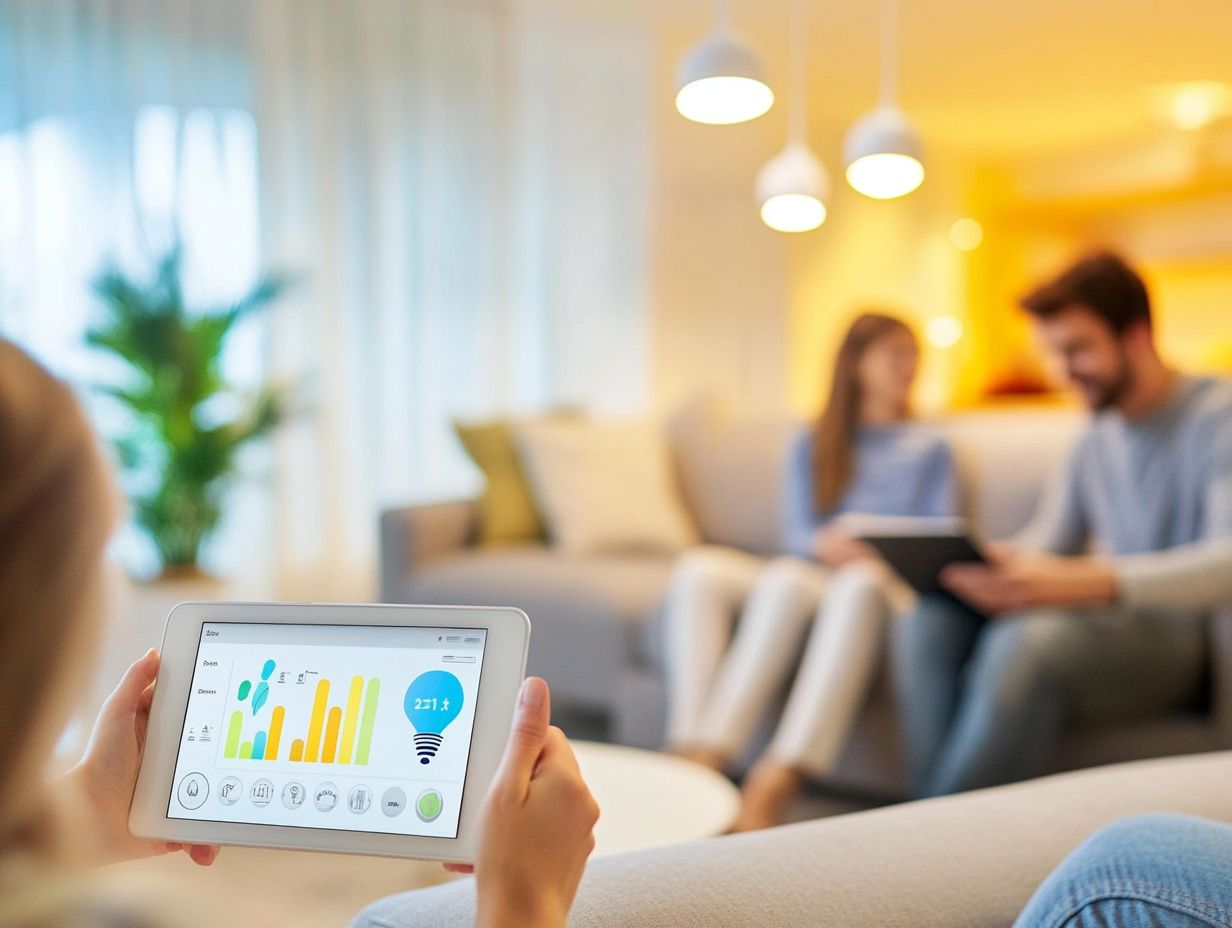
What are the benefits of using smart home tech for savings?
There are several benefits to utilizing smart home technology for savings, including reduced energy consumption, increased convenience, and potential cost savings on utility bills. Certain devices, like smart sprinkler systems and water leak detectors, can also contribute to significant savings.
What are some easy ways to incorporate smart home tech for savings?
Some simple ways to utilize smart home technology for savings include installing a programmable thermostat, using smart light bulbs, and investing in a smart power strip, a device that helps control power supply to connected devices. Smart switches help automate lighting control, making it easier to manage energy usage.
Can smart home technology really save me money on my utility bills?
Yes! Smart home technology allows you to control and monitor your energy usage more effectively. This can help you save money on your utility bills and identify areas where you might waste energy.
Are there any upfront costs associated with using smart home technology for savings?
Yes, there may be some initial costs for purchasing and installing devices. However, these costs are often less than the long-term savings on your utility bills.
Look for products that are Energy Star certified to ensure energy savings and efficiency.
What type of smart home technology is best for saving money on energy costs?
There are various smart devices that can help save money, including smart thermostats, smart lighting, and smart power strips. The best choice depends on your specific needs and preferences.
Can smart home technology help me save money in other ways besides energy costs?
Absolutely! Smart home technology can reduce water usage and improve home security, which can lead to savings on insurance policies. Devices like Amazon Echo Dot, Google Nest, and Ecobee are excellent examples of tech that can help you save money.


